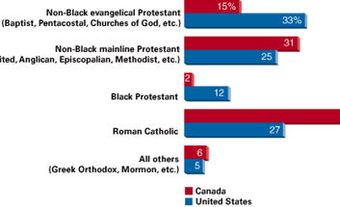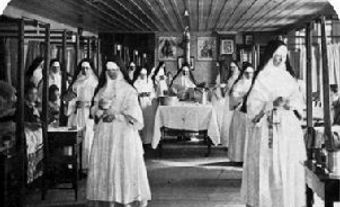Anglicanism is that tradition in Christianity whose members are in full communion with the see of Canterbury, England. Originally confined to the British Isles, the Church of England has spread to many parts of the world. In the 2011 National Household Survey (NHS), 1,631,845 Canadians identified as Anglican.
Origins
Anglicanism considers itself to stand within the primitive Catholic tradition, preserving a solid scriptural basis; a ministry of bishops, priests and deacons in unbroken succession from the time of the Apostles; a sacramental order; and a recognition of church tradition which is nevertheless freed from medieval excesses and superstitions. In this sense, Anglicanism is both Catholic and a product of the 16th-century Reformation. The word "Protestant" is sometimes applied to it, but this is confusing because the same word is also applied to the nonepiscopal bodies that appeared at the time of the Reformation. In Scotland, the United States and elsewhere, Anglicans are also known as Episcopalians.
Anglicanism stands within the Greco-Gallican (theological and liturgical) tradition. Its nature is to emphasize community and loving relationships as distinct from the legal conformity emphasized by the Latin (Roman Catholic) tradition. It has been concerned with reunifying the Christian faith and has a long history of what are now known as ecumenical encounters.
In Canada, discussion among various Protestant bodies in the late 19th century were precursors to the formation of the United Church of Canada in 1925. Anglicans took no part in these early negotiations, but began discussions with the United Church in the 1940s and from 1969 included the Christian Church (Disciples of Christ).
"Plan of Union"
The resulting "Plan of Union" proposed that the Protestant bodies accept the episcopal church structure, and attempts were made to deal with differences in theology. Limited practical co-operation included sanctioning a joint calendar and a common hymn book. But by the early 1970s enthusiasm had cooled, and in 1975 the Anglican Church formally withdrew from negotiations on the grounds that the nonepiscopal bodies had failed to realize that they were not dealing with another Protestant group.
There has been a greater possibility of understanding between Anglicanism and the Church of Rome, although it has been hindered by doctrinal differences and, since the first Vatican Council (1870), by the refusal of Rome to recognize Anglican ordinations. The Anglican-Roman Catholic International Commission issued a report on the first stage of its deliberations in 1981. This indicated the possibility of agreement on the Eucharist, ordination and the nature of authority in the church. The talks continued in 1987 on the remaining differences and practical ways of bringing a reconciliation.
Modern Form
In its modern form Anglicanism has been a religion of two books: the Bible and The Book of Common Prayer. It understands the Bible as fons et origo of Christian truth but also as subject to interpretation by the church; tradition plays an important part in its understanding. Anglican scholars have been in the forefront of biblical studies. Anglicanism is also liturgical in its worship. The first prayer book, which appeared in 1549 and was largely the work of Archbishop Thomas Cranmer, was a compilation of ancient biblical and Catholic worship. Current revisions used throughout the world still reflect Cranmer's influence. The Book of Common Prayer has been described as the Bible arranged for worship. The Liturgical Movement of the 20th century has had far-reaching effects on Anglicanism, as on all other liturgical churches.
In Canada, as in some other branches of the Anglican communion, the prayer book has been supplemented by a Book of Alternative Services which, it is anticipated, will contribute to the pattern of a future Book of Common Prayer. Anglicanism emphasizes a ministry of Word and Sacrament. The Eucharist, in theory and increasingly in practice, is the principal Sunday service. There has been some tension between scriptural and sacramental emphasis, the evangelical (low-church) position emphasizing the ministry of the Word and personal religious experience, the Catholic (high-church) position seeing the church as a divine society, the Body of Christ, administering the grace of God through the sacraments.
There has always been flexibility in Anglican theology, and hence Anglicanism has not always seemed to present the same face to the world. But because wide differences of interpretation and practice are possible within Anglicanism, schisms have been rare. In "Old Dissent" the principal examples, Congregationalists (or Separatists) and Anabaptists (who originally included those later called Baptists), represent not so much a dissent from Anglicanism itself as a doctrinal divergence from Catholicism in general. The outstanding example of "New Dissent" was Methodism, in which the differences were less doctrinal than practical and behavioural, and the schism was due to misunderstanding and intransigence on both sides.
More recently the only schisms of note have been those of the Reformed Episcopal movement in the 19th century and the Anglo-Catholic group in the 20th. The Reformed Episcopal Church, founded in 1843 in the US to protest against "ritualism," appeared in England the following year as the Free Church of England, and in Canada, chiefly in Ontario and British Columbia, about the same time. It was distinctively evangelical and strongly opposed to what it considered to be romanizing tendencies. It has virtually disappeared in the 20th century.
The Anglican Catholic Church, which gained a small following in Canada, was born of a reaction against what was regarded as liberalization in the Episcopal Church of the US in the 1970s. Particular objection was taken to proposed revisions of the prayer book and to the admission of women to holy orders. This has been one of the significant changes in modern Anglicanism. Women were admitted to synods in the 1950s and to ordination in 1976. In 1987 there were 176 women clergy. In 1993 there were 368 women clergy. The Right Reverend Victoria Matthews was elected and consecrated as Suffragan Bishop of Toronto in 1993.
Anglicans have always been interested in education and have been active in the establishment and support of schools and colleges. Many Canadian universities were originally either Anglican foundations or have been strongly supported by Anglicans.
History in Canada
The first known service in what is now Canada was performed by Robert Wolfall, a chaplain in Sir Martin Frobisher's expedition, in Frobisher Bay (Iqaluit) on 2 September 1578. Thereafter Anglicanism spread through immigration from the British Isles and the coming of Loyalists, many of whom were Anglicans, after the American Revolution. In the British colonies it was tacitly assumed that, without special legislation, the Church of England was the established or "official" church, with the same status and limitations as in the mother country. This was not always understood by the people, particularly non-Anglicans, or by the authorities. Establishment was a thorny issue, hotly debated throughout early Canadian history (see Clergy Reserves). The purpose of 18th-century Nova Scotia legislation was not to "establish" the Church of England, since that was taken for granted, but to assure Protestants of freedom of worship and to exclude Roman Catholics. Establishment imposed certain responsibilities in the conduct and registration of baptisms, marriages and burials, important in the days before state registration of vital statistics. It did not imply that the church had coercive powers to compel support, nor that it derived financial advantage from the state.
In early Canada there was no local church organization. Church of England clergy had been sent by the missionary societies or were military chaplains (see Missions and Missionaries). In keeping with the principle of establishment, the governor was the ordinary (chief ecclesiastical officer) and made necessary organizational decisions which might include appointments to parishes and the issue of marriage licences; he had no sacramental or ecclesiastical powers.
Missions
Missions were the work of the society for the Propagation of the Gospel, founded in 1701, an extension of the Society for Promoting Christian Knowledge, founded in 1698; the Church Missionary Society, founded in 1799; and the Colonial and Continental Church Society (CCCS), founded in 1838. The two former societies undertook the whole of Anglican missionary work among Indigenous peoples in British North America until the 1905 formation of the Missionary Society of the Church in Canada, and continued to support a large part until the 1940s. CCCS was an evangelical society which concentrated on ministering to settlers. Beyond that, its greatest single work was maintaining Emmanuel College, Saskatoon (Saskatchewan) for the training of clergy from 1914-54.

The first Anglican bishopric in British North America was that of Nova Scotia, established in 1787 with Loyalist Charles Inglis as bishop. Although he was styled bishop of Nova Scotia, his jurisdiction included Newfoundland, Bermuda, Prince Edward Island, Lower Canada, and Upper Canada. His load was lightened in 1793 with the creation of the Diocese of Quebec with Jacob Mountain as bishop. The diocese of Quebec was further subdivided in 1839 when John Strachan became the first bishop.

Strachan was a colourful and sometimes controversial figure who contributed greatly to the ecclesiastical, political and educational life of his times. In a real sense he was the founder of University of Toronto and of the University of Trinity College in Toronto. During his episcopate the see was subdivided to form the dioceses of Huron and Ontario. In 1860 the six dioceses - Nova Scotia, Quebec, Toronto, Fredericton, Montreal and Huron - had combined to form the Provincial Synod of the Church of England and Ireland in Canada.
Legislative and Administrative Bodies
The General Synod of the Church of England in Canada was formed in 1893 with the first sessions at Trinity College in Toronto in September. The General Synod is a legislative and administrative body with clerical and lay representatives from each diocese. Its presiding bishop was accorded the title Primate of All Canada.
The Provincial Synod of Rupert's Land was formed in 1875. The diocese of Rupert's Land had been created in 1849 with David Anderson as the first bishop. In the time of his successor, Robert Machray, the see was subdivided by the formation of the dioceses of Moosonee in 1872, with John Horden as the first bishop, and Saskatchewan and Athabasca with John McLean and William Carpenter Bompas respectively in 1874. A bishop was elected in each province to act as presiding bishop, or metropolitan, and in 1893 it was decided they should be styled "archbishop."
In 1912, the five dioceses in the civil province of Ontario (Toronto, Huron, Ontario, Niagara, Ottawa and Algoma) were separated from the province of Canada to form the ecclesiastical province of Ontario. Similarly, in 1914 the dioceses of BC, previously without any provincial organization, combined in the ecclesiastical province of British Columbia. The modern Anglican Church of Canada (the name was changed in 1955) is made up of 30 dioceses distributed in 4 provinces each with a metropolitan archbishop.
Did you know?
The flag of the Anglican Church of Canada is the red St. George's cross with a green maple leaf in each quarter.
Tension Between Spirituality and Social Welfare
In the 19th century, Anglican missionaries often failed to distinguish between evangelization and acculturation, tacitly assuming that to be Anglican was to be English. This led to difficulties in later years. In the 20th century, there has been tension between the claims of spirituality and those of social welfare. The church has always been concerned for the needy (in England it was for many years the only agency for the relief of the poor). In 1908 a committee on Moral and Social Reform (later the Council of Social Service) was set up by the Canadian General Synod. It laboured long to awaken and inform the social conscience of Canadian Anglicans. Organizational structures at the national level have changed, but the church continues to be actively involved in social issues such as abortion and birth control, social and economic problems, the peace movement and Indigenous rights.

 Share on Facebook
Share on Facebook Share on X
Share on X Share by Email
Share by Email Share on Google Classroom
Share on Google Classroom


